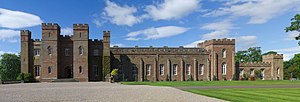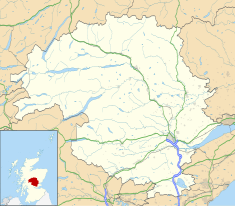Scone Palace
| Scone Palace | |
|---|---|
 Scone Palace, front façade | |
| Location | Perth, Perth and Kinross, Scotland, United Kingdom |
| Coordinates | 56°25′22″N 03°26′18″W / 56.42278°N 3.43833°W |
| Built | 12th century |
| Rebuilt | 1802–1807 |
| Architect | William Atkinson |
| Architectural style(s) | Gothic Revival style |
Scone Palace
Scone was originally the site of an early Christian church, and later an
The Palace and its grounds, which include a collection of fir trees and a star-shaped maze, are open to the public.
History of Scone

Prehistory and tradition
Scotland was one of the last kingdoms to adopt and benefit from the written word and the legal system it upheld. Only at the end of the 11th century did Scotland see a growth of record keeping, with property rights logged via legal charter and royal government practice noted in writing.[1] It is likely that there were a few documents written before the 11th century, however, Scotland's particularly turbulent history is likely to have been witness to the loss or destruction of many documents. The first piece of hard evidence that relates to Scone is a charter dating to 906.[2]
Naming of Scone
It is not known why exactly the area is called "Scone" (pronounced
It was thus believed that "Scone" derives from the P-Celtic word "Sken" meaning "cut" or "cutting". This has been gaelicized as "Sgàin" (pronounced "Skene"). And may be a fine example of the amalgamation of the Pictish and Gaelic cultures and languages. The Brittonic origin of the place-name "Scone" is of great importance regarding the history and status of the place, and may explain why the famous
The meaning "cutting" could relate to what is now known as "the Friars' Den".
Ancient Kingdom of Scone
Scone was from at least the 9th century the crowning-place of the
Scone was thus the centre of power in the ancient
As the Bell of Scone rang, So mote it be.[8]
This saying has often been re-quoted as "When the Bell of Scone tolls, the law of the land has been made". It is a statement of the great significance of the ceremonies held at Scone, and the judgments made from a top the
Comhairle clag Sgàin: An rud nach buin duit na bean dà.[9]
"Counsel of the bell of Scone, Touch not what is not thine own."
In
The mons placiti or Scone
Scone Abbey
Scone was an ancient gathering place of the
From 1114 to 1559, Scone was one of Scotland's major monasteries and later abbeys. The monastery's status was 'formalised' as a result of King Alexander I's charter. A representation of the church on the Abbey's seal, and some surviving architectural fragments, show that it was built in the Romanesque style, with a central tower crowned with a spire. Between 1284 and 1402 Scone Abbey (sometimes referred to as the Palace of the Abbots) often served to house the Parliament of Scotland.[15]

Scone Abbey flourished for over four hundred years. In 1559, it fell victim to a mob from Dundee during the early days of the Reformation and was largely destroyed. In 1580 the abbey estates were granted to Lord Ruthven, later the Earl of Gowrie, who held estates around what is now called Huntingtower Castle. The Ruthvens rebuilt the Abbot's Palace of the old abbey as a grand residence. In 1600, James VI charged the family with treason and their estates at Scone were passed to Sir David Murray of Gospetrie (later known as Lord Scone), one of James' most loyal followers.[17]
In 1604, the Palace of Scone was the family seat of the
Modern palace


The modern palace, which was designed by William Atkinson in the Gothic Revival style for the 3rd Earl of Mansfield and built in red sandstone with a castellated roof, was completed in 1807.[19] One of its best known features is the gallery.[20]
Landscaping work around the Palace was undertaken by
On view in the State Rooms of Scone Palace are collections of furniture, ceramics, ivories, and clocks. Some of the prized contents of Scone Palace are
The Lennox Room, named after the
The collection of large European ivories came from Bavaria, Italy and France. They were carved in the 17th, 18th and 19th centuries in elephant and walrus tusk, and collected mainly by


The grounds of Scone Palace include the

The Murray Star shaped maze covers an area of 1600 square meters. It is planted in a mixture of copper and green beech, designed to resemble the Earl of Mansfield's family tartan, Ancient Murray of Tullibardine, and is in the shape of a five-pointed star which is part of the Mansfield family emblem.[29]
There are fine woodlands in the grounds and policies of Scone Palace, some of the fir trees being at least 250 years old. The grounds of the Palace were the first place in Britain to which David Douglas introduced the Douglas fir tree species.[30]
Notable gardeners
References
- General
- Adam, Frank and Thomas Innes (2010). The Clans, Septs and Regiments of the Scottish Highlands 1934. Kessinger Publishing. ISBN 978-1163203309
- Christie, Christopher, The British Country House of the Eighteenth Century, Manchester University Press, Oxford (2000) ISBN 0719047242
- Norwich, John Julius, Treasures of Britain: the Architectural, Cultural, Historical and Natural History of Britain, W. W. Norton Publishing (2002) ISBN 0393057402
- Specific
- ^ "Scottish medieval history documents put online". 4 September 2012 – via www.bbc.co.uk.
- ISBN 1871615038
- ^ Bede HE I.1; references to Pictish also at several other points in that text.
- doi:10.1093/ref:odnb/15398. (Subscription or UK public library membershiprequired.)
- ^ Perth, the Ancient Capital of Scotland. The Story of Perth from the Invasion of Agricola to the Passing of the Reform Bill by Samuel Cowan J.P. (1904).
- ^ Watson 1926; Jackson 1955; Koch 1983; Smyth 1984; Forsyth 1997; Price 2000; Forsyth 2006; Woolf 2007; Fraser 2009
- ^ After Anderson, Early Sources, p. 445.
- ^ After Cowan, Perth, the Ancient Capital of Scotland, p. 85.
- ^ "The Bells of Perth" (PDF). Pipes and Drums. Retrieved 22 June 2021.
- ^ Skene (1867), pp. 84, 97.
- ISBN 978-0064918305.
- ^ "The Moot Hill – Scone Palace". Archived from the original on 7 August 2007.
- ^ Bannerman, "Scottish Takeover", p. 79.
- ^ a b Historic Environment Scotland. "Moot Hill royal assembly place and Scone Abbey, 100m north east of Scone Palace (SM13595)". Retrieved 21 June 2021.
- ^ Barrow, G. W. S. "A Kingdom in Crisis: Scotland and the Maid of Norway." The Scottish Historical Review, vol. 69, no. 188, 1990, pp. 120–141. JSTOR, www.jstor.org/stable/25530459. Accessed 22 June 2021.
- ^ "Honours of Scotland and Stone of Destiny". Visit Scotland. Retrieved 6 August 2018.
- ^
 This article incorporates text from a publication now in the public domain: "Murray, David (d. 1631)". Dictionary of National Biography. London: Smith, Elder & Co. 1885–1900.
This article incorporates text from a publication now in the public domain: "Murray, David (d. 1631)". Dictionary of National Biography. London: Smith, Elder & Co. 1885–1900.
- ISBN 978-0859921633.
- ^ Historic Environment Scotland. "Scone Palace including terraces (LB18370)". Retrieved 21 June 2021.
- ISBN 978-0950156453.
- ^ Historic Environment Scotland. "Scone Palace (GDL00338)". Retrieved 21 June 2021.
- ^ Grant, John (1842). Her majesty queen Victoria's visit to Scotland. London: E. Jones. p. 55.
- ISBN 978-0719047251.
- ^ Sir David Wilkie (1868). The great works of Sir David Wilkie, 26 photogr. from engravings of his paintings, with a descriptive account of the pictures and a memoir of the artist by mrs. Charles Heaton. p. 17.
- ISBN 978-0442299620.
- ^ "A Palace of Splendour". Scone Palace. Retrieved 22 June 2021.
- ^ Pearson, Fiona ed., Virtue and Vision, Sculpture and Scotland, National Galleries of Scotland (1991), 28.
- ^ Fittis, Robert Scott (1878). Sketches of the Olden Times in Perthshire. Printed at the Constitutional office.
- ^ "Scone Palace is Scotland's big day out". Scottish Field. 30 May 2019. Retrieved 22 June 2021.
- ^ Trust Walks: "Dunkeld and The Hermitage," a podcast by the National Trust for Scotland; 27 June 2009

